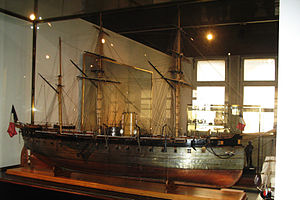French ironclad Gauloise
The French ironclad Gauloise was one of 10 Provence-class ironclads built for the French Navy (Marine Nationale) during the 1860s.
 A scale model of sister ship Flandre | |
| History | |
|---|---|
| Name: | Gauloise |
| Namesake: | Gauloise |
| Builder: | Arsenal de Brest |
| Laid down: | 24 January 1861 |
| Launched: | 26 June 1865 |
| Commissioned: | 5 December 1867 |
| Fate: | Condemned, 13 October 1883 |
| General characteristics (as completed) | |
| Class and type: | Provence-class ironclad frigate |
| Displacement: | 5,700–6,000 t (5,600–5,900 long tons) |
| Length: | 80.72 m (264 ft 10 in) |
| Beam: | 17 m (55 ft 9 in) |
| Draft: | 7.7–8.8 m (25 ft 3 in–28 ft 10 in) |
| Installed power: |
|
| Propulsion: | 1 shaft, 1 horizontal-return connecting rod-steam engine |
| Sail plan: | Barque-rig |
| Speed: | 15.1 knots (28.0 km/h; 17.4 mph) (trials) |
| Range: | 2,410 nautical miles (4,460 km; 2,770 mi) at 10 knots (19 km/h; 12 mph) |
| Complement: | 579–594 |
| Armament: | 11 × single 194 mm (7.6 in) smoothbore muzzle-loading guns |
| Armor: |
|
Design and description

The Provence class was designed as an enlarged version of the Gloire-class ironclads with thicker armor, more powerful guns, and better seakeeping qualities. The ships had an overall length of 80.72 meters (264 ft 10 in), with a beam of 17 meters (55 ft 9 in), and a draft of 7.7–8.8 meters (25 ft 3 in–28 ft 10 in), depending on the load. They displaced between 5,700–6,000 metric tons (5,600–5,900 long tons).[1] Like most ironclads of their era they were equipped with a metal-reinforced ram.[2] They had a crew of 579–594 officers and enlisted men.[3]
The ships of the Provence class had a single horizontal-return connecting-rod compound steam engine that drove a single propeller shaft,[4] using steam provided by eight boilers[Note 1].[3] The engine was rated at 1,000 nominal horsepower or 3,200 metric horsepower (2,400 kW) and was intended to give the ships a speed in excess of 13 knots (24 km/h; 15 mph). During her sea trials, Gauloise achieved a speed of 15.1 knots (28.0 km/h; 17.4 mph) from 3,895 metric horsepower (2,865 kW).[3] The Provence class carried enough coal to allow them to steam for 2,410 nautical miles (4,460 km; 2,770 mi) at a speed of 10 knots (19 km/h; 12 mph).[5] They were fitted with a three-masted barque rig that had a sail area of 1,960 square meters (21,100 sq ft).[4]
Armament and protection
The main battery of the Provence-class ships was intended to be thirty 164.7-millimeter (6.5 in) Modèle 1858–60 rifled muzzle-loading (RML) guns, but this was changed to eleven 194-millimeter (7.6 in) Modèle 1864 smoothbore muzzle-loading guns in 1865.[3][4][5] Ten of the guns were mounted on the broadside and one was on a pivot mount below the forecastle deck as a chase gun. Three years later, their armament was changed to eight 240-millimeter (9.4 in) RMLs and four 194 mm smoothbores.[3]
From the upper deck down to below the waterline, the sides of the ships were completely armored with 150 mm (5.9 in) of wrought iron. The sides of the battery itself were protected with 110 mm (4.3 in) of armor.[3] The conning tower's sides consisted of 102-millimeter (4 in) armor plates.[5]
Construction and service
.jpg)
Gauloise, an inhabitant of Gaul,[6] was laid down on 24 January 1861 by the Arsenal de Brest, launched on 26 April 1865 and commissioned on 5 December 1867.[3]
Notes
Citations
- Gille, pp. 26, 30
- Campbell, p. 287
- Gille, p. 30
- de Balincourt and Vincent-Bréchignac 1975, p. 10
- Silverstone, p. 62
- Silverstone, p. 99
Bibliography
- de Balincourt, Captain; Vincent-Bréchignac, Captain (1975). "The French Navy of Yesterday: Ironclad Frigates: Second Group – Provence Type". F.P.D.S. Newsletter. III (2): 9–13. OCLC 41554533.
- Campbell, N. J. M. (1979). "France". In Chesneau, Roger & Kolesnik, Eugene M. (eds.). Conway's All the World's Fighting Ships 1860–1905. Greenwich, UK: Conway Maritime Press. pp. 282–333. ISBN 0-8317-0302-4.
- Gille, Eric (1999). Cent ans de cuirassés français [A Century of French Battleships] (in French). Nantes: Marines. ISBN 2-909-675-50-5.
- Konstam, Angus (2019). European Ironclads 1860–75: The Gloire Sparks the Great Ironclad Arms Race. Oxford, UK: Osprey Publishing. ISBN 978-1-47282-676-3.
- Silverstone, Paul H. (1984). Directory of the World's Capital Ships. New York: Hippocrene Books. ISBN 0-88254-979-0.
- Wilson, H. W. (1896). Ironclads in Action: A Sketch of Naval Warfare From 1855 to 1895. 1 and 2. Boston: Little, Brown.
- Winfield, Rif & Roberts, Stephen S. (2015). French Warships in the Age of Sail, 1786–1861. Barnsley, UK: Seaforth Publishing. ISBN 978-1-84832-204-2.